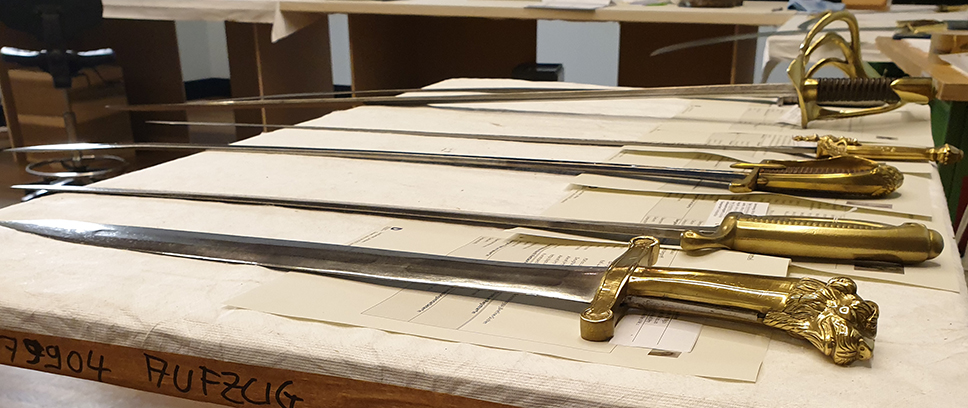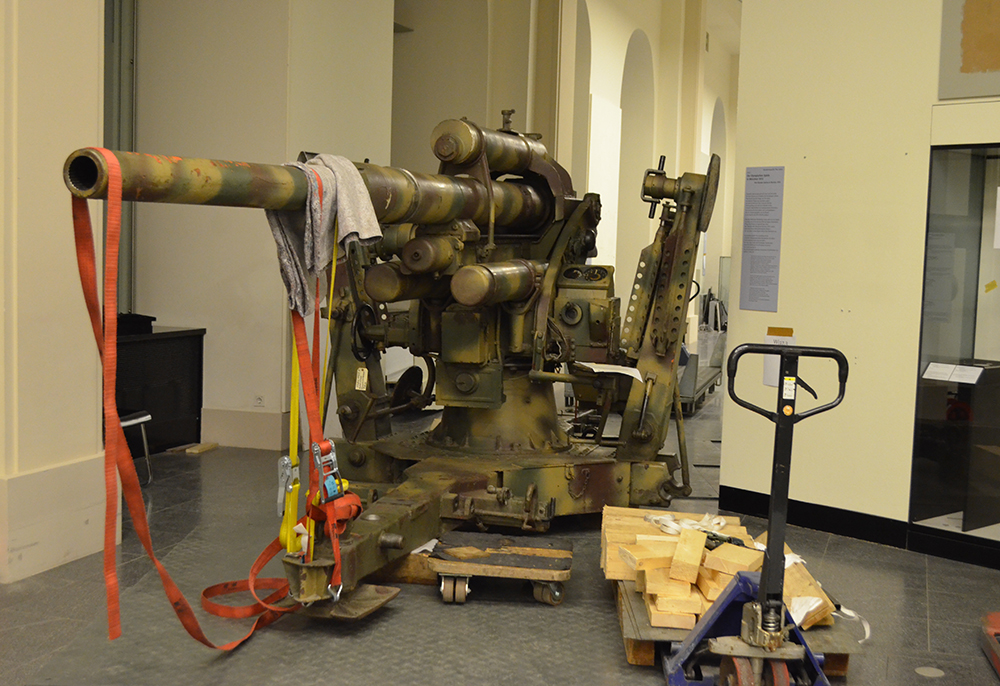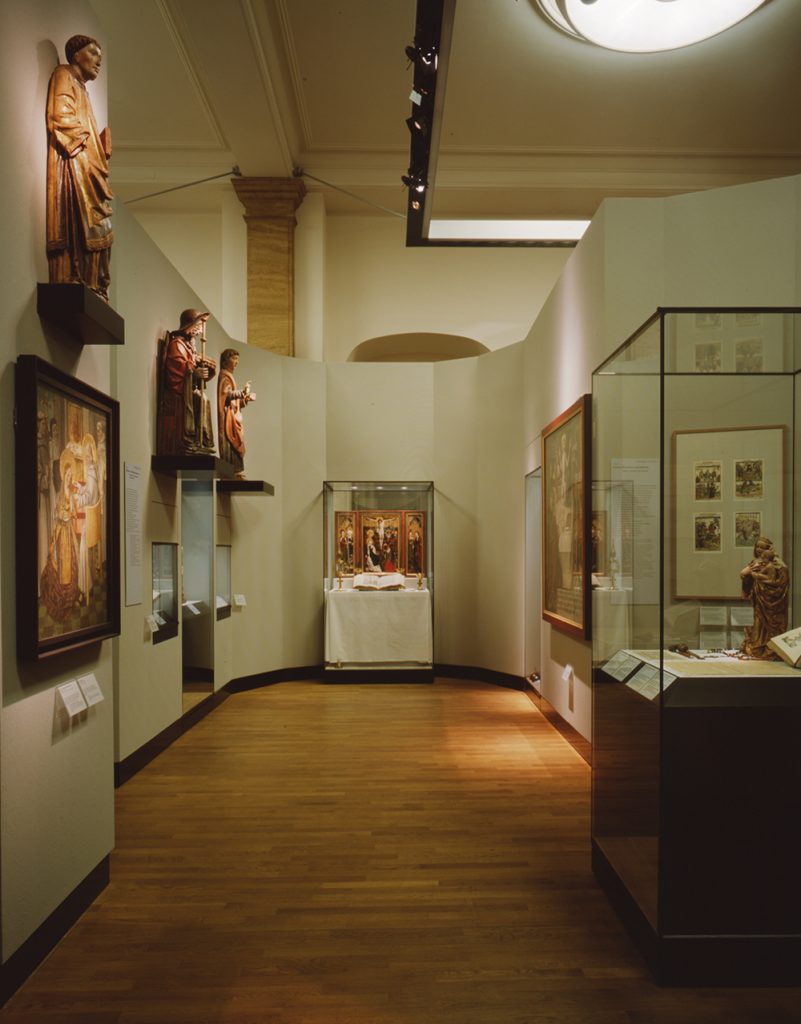
5 Questions for: Dr. Sven Lüken
5 January 2022
The Zeughaus, the Deutsches Historisches Museum’s main building, is currently closed for renovation and the permanent exhibition “German History from the Middle Ages to the Fall of the Berlin Wall” is being carefully dismantled and put into storage. At the same time, the DHM is busy working on plans for a new Permanent Exhibition – a major project affecting all departments across the museum. In our interview series „5 Questions for…“, we give museum curators and staff the chance to talk about their personal memories of the last permanent exhibition and what they are working on now. Next up answering our questions is Dr. Sven Lüken, head of Militaria collection.
Mr. Lüken, the permanent exhibition shut in late June. Was there a particular object or section in the exhibition that had a special place for you as curator?
Dr. Sven Lüken: Yes, it would have to be this anti-aircraft gun, which played a major role in ground combat because it quickly shot through armour plating, making it also effective as an anti-tank gun. This ground-combat function was not its planned use, but it quickly meant that every soldier knew of the “Eight Eight”, as it was called by German troops, through the ground support it offered. It makes this particular weapon one of the most revered and dreaded “fossils” of WWII, if you will, of a size that we can only just about accommodate in the galleries. In 2001, I was hired by the DHM as an economic and social historian. Later I worked in the medieval department on curating the permanent exhibition. My academic background is actually as a historian of religion, but I’ve always had an interest in militaria. When the last permanent collection display was mounted, the 8.8 Flak was the very first object to be installed in the Zeughaus. The building was still empty at the time and you could see it from outside on the street. Throughout the day, you’d see people pressing their noses up against the glass to take a peek. In January 2008, I was made custodian of militaria, and from then on the anti-aircraft gun was part of my remit. Just like the visitors, the first thing I wanted to know was how the thing worked. It took twelve people to operate it, each with a distinct task. But I also wanted to know what kind of people they were. What were their common experiences of warfare? How did they go on to shape West-German society as the first postwar generation of the newly founded Federal Republic? This generation is referred to in German as the Flakhelfer-Generation.In the final war years, the artillery batteries were usually made up of children in their mid-teens and they effectively grew up servicing guns like this. These gun “helpers” learned to defer to others, that the only way to get the job done – in this case shooting down a bomber – was by acting together as part of a well-oiled machine. All that counted was “us”, not “me”. Whenever they shot down a bomber, they would paint a white ring around the barrel as a kind of trophy mark and a badge of pride. On 8 May 1945, their entire world came crashing down around their ears, and their efforts were meaningless. Their time as “helpers” left an indelible mark, and later this generation used its wartime experiences to build a welfare state and a democracy. Seen like this, I thought this object made a brilliant museum exhibit – one that serves as a springboard into many areas of history. That’s why I’d say it has a special place for me as curator.

How many objects from your collection area featured in the permanent exhibition? Can you tell us what the biggest was? And what was the smallest?
There were some 400 objects from my collection area on display in the Zeughaus. But the number we will probably be able to show in the new permanent exhibition will be significantly lower than that.
The Flak was the largest object. In our storage facility we still have a tank from the Kasernierte Volkspolizei (precursor to the East-German NVA). Self-made, it dates from a time when the Germans were actually prohibited from building tanks by the Allies. Our object was built as a prototype under the aegis of the Soviets and was involved in the suppression of the demonstrations on 17 June 1953. That’s also how it came to be displayed in the Museum für Deutsche Geschichte, the East-German history museum whose collection was absorbed into the DHM. That’s the largest object in the collection, I think. However, we also have a Soviet surface-to-air missile.
And at the other end of the scale, the smallest objects we have are tiny screws, components of locks, as in “flintlocks”. We also have a whole production line for the Gewehr 98, which is on permanent loan to the Zitadelle Spandau. Having the entire production line allows you to see how the parts were assembled. But most of the objects in the Militaria Collection are big, bulky, and relatively easy to preserve.
As you said, you were already working at the museum during the planning stages for the last permanent exhibition. Does anything stick out in your mind from that time?
That was a frenetic time and it went on for ages. Hans Ottomeyer, president of the DHM at the time, used to jest that the “permanent” exhibition was only called that because the planning and set-up was so never-ending, they practically became permanent. There are many stories that spring to mind from that time. Here’s one, for example: I was fortunate enough to be given a small section on piety in the Late Middle Ages and was even allowed to purchase new objects for the display, which is a great privilege. In Würzburg, for example, I bought an entire altarpiece from two art dealers in one afternoon. We then set it up, and over the next few years I ended up giving many a guided tour on late medieval piety. That’s no easy task, I’m telling you, in Berlin and Brandenburg, which aren’t traditionally known for being big on religion. Sometimes I felt like Saint Boniface, but the visitors were interested in what I had to say. In relating this aspect of history, I found my calling as a museum historian.

What was the biggest challenge for you in dismantling the permanent exhibition with regard to your collection area and were there any surprises in store for you?
When I took over the militaria department in 2008, the permanent exhibition had already been on view for two years. That meant I only knew the most beautiful exhibits from behind glass, not close up. It has been quite an experience seeing the many beautiful objects “naked” again. The exhibits are going into storage, which means I have many appointments and incoming calls. With the display cabinets out the way, the objects are now easier to get to and so we’ve naturally had dozens of inquiries, for example from curators and historians wanting to work with the objects. I am glad to be able to make that happen. One of the privileges of working in a collection is that history literally becomes the air that we breathe. We get to handle horse gas masks from WWI which are still impregnated by the smell of the horse’s fear; uniforms that sometimes still carry the smell of combatants’ sweat. But the most important thing is that scholars now have the chance to examine the objects from all angles, not just the side previously on show to visitors.
Sometimes the inventory numbers don’t match up. That’s something we occasionally have to sort out. Otherwise there haven’t been any surprises to speak of. But the provenances of certain objects still have to be clarified: for example, two 15th century ivory saddles from Budapest. A Hungarian colleague is currently researching their origin.
Can we finish by looking to the future? Is there an object that, in your opinion, simply has to be included in the new permanent exhibition? And what shape will the collection take in future when it comes to the subject of “warfare”, which, after all, has seen such major changes in recent years? How would you curate a display on, say, cyberwarfare, for example?
I would be happy to see our 15th and 16th century jousting armour and weaponry featured in the new permanent exhibition, as these items really rank as highlights of European art history.
Otherwise, in answer to your second question: it’s a real challenge for us to get our hands on newer exhibits. Our most recent example of a rifle dates from the final years of the GDR. In our collection’s former iterations, the objects were entrusted to us, in our role as either the Royal Prussian Armoury or, later, the Armoury Museum. They came mainly from the army – be it Prussian, Imperial German, or the Wehrmacht, and, in most recent times, the Bundeswehr. That’s no longer possible today because, technically, such accessions fall under German gun-control laws and the highly regulated arms trade (Waffengesetz or Weapons Act). There is only one museum in Germany that is exempt from the law – the Militärhistorisches Museum der Bundeswehr in Dresden – which, as the name suggests, is the official museum of the German army. Its accessions are not subject to the Waffengesetz. Even military uniforms fall under the Waffengesetz. And as to your question of how to exhibit cyberwarfare without having a single object to show for it, well, that is of course a problem. We’ll just have to see how things develop on that front.